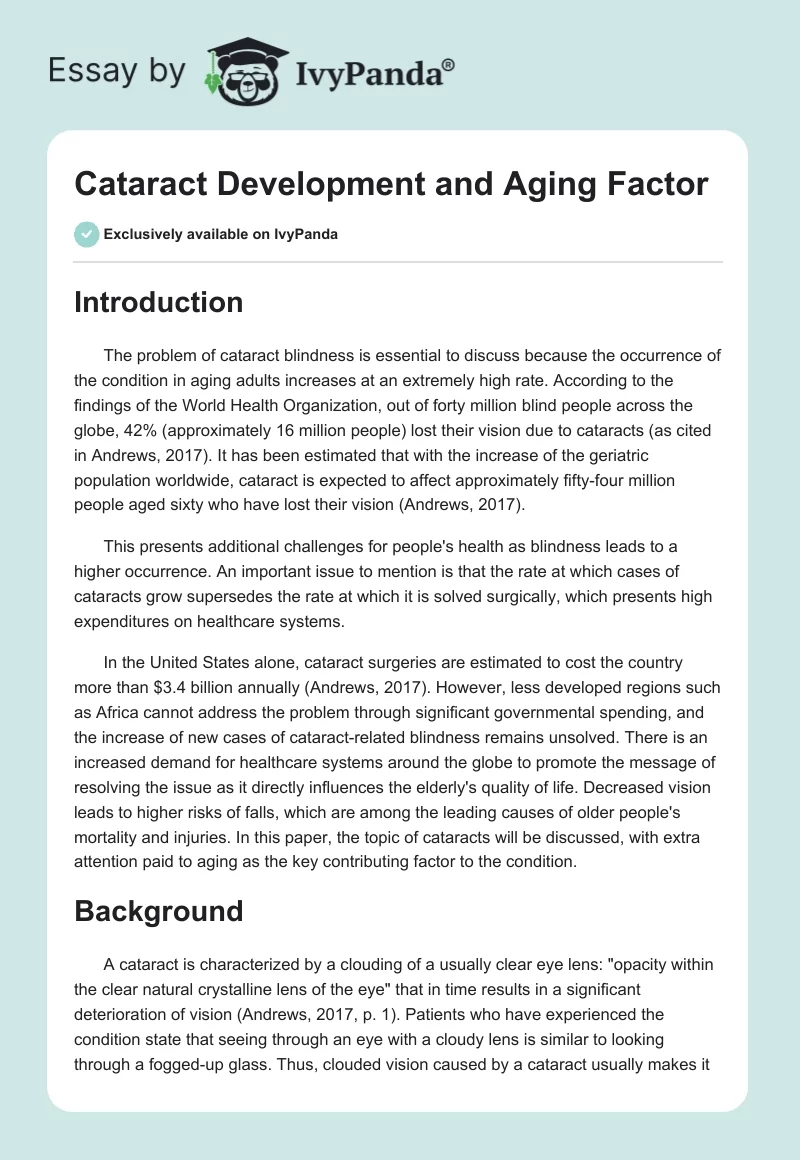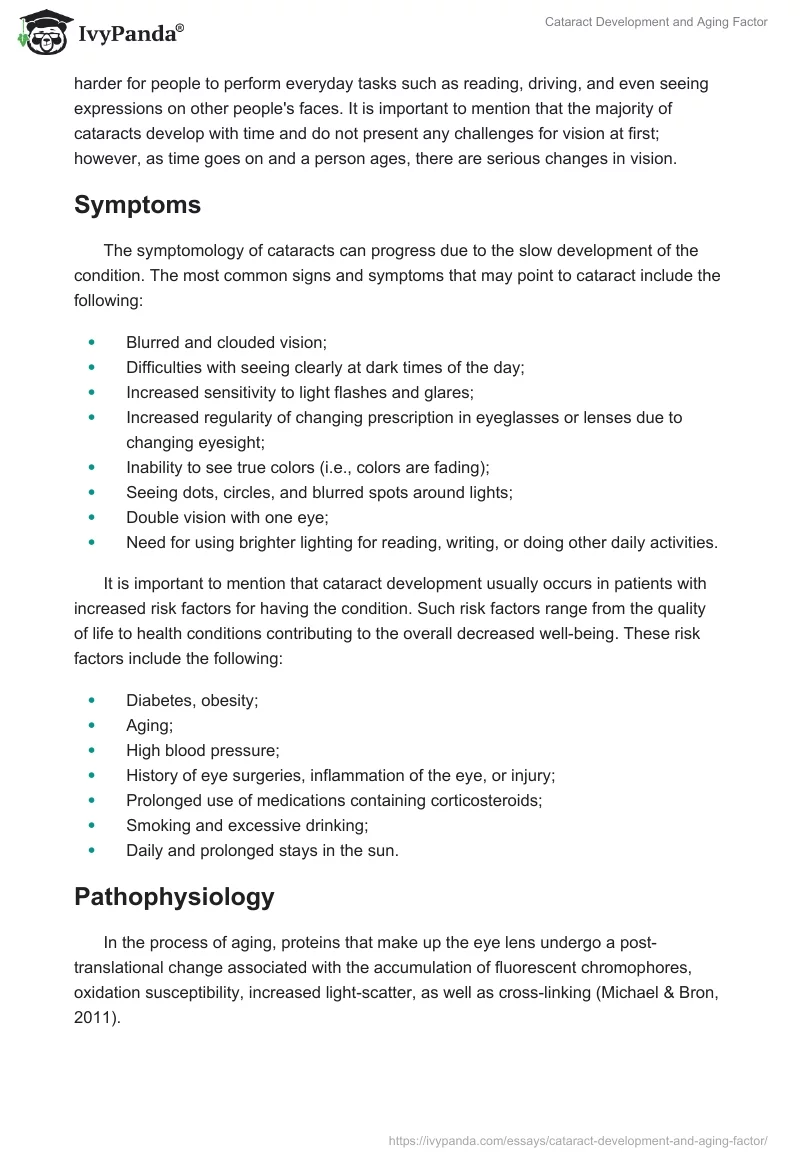Introduction
The problem of cataract blindness is essential to discuss because the occurrence of the condition in aging adults increases at an extremely high rate. According to the findings of the World Health Organization, out of forty million blind people across the globe, 42% (approximately 16 million people) lost their vision due to cataracts (as cited in Andrews, 2017). It has been estimated that with the increase of the geriatric population worldwide, cataract is expected to affect approximately fifty-four million people aged sixty who have lost their vision (Andrews, 2017).
This presents additional challenges for people’s health as blindness leads to a higher occurrence. An important issue to mention is that the rate at which cases of cataracts grow supersedes the rate at which it is solved surgically, which presents high expenditures on healthcare systems.
In the United States alone, cataract surgeries are estimated to cost the country more than $3.4 billion annually (Andrews, 2017). However, less developed regions such as Africa cannot address the problem through significant governmental spending, and the increase of new cases of cataract-related blindness remains unsolved. There is an increased demand for healthcare systems around the globe to promote the message of resolving the issue as it directly influences the elderly’s quality of life. Decreased vision leads to higher risks of falls, which are among the leading causes of older people’s mortality and injuries. In this paper, the topic of cataracts will be discussed, with extra attention paid to aging as the key contributing factor to the condition.
Background
A cataract is characterized by a clouding of a usually clear eye lens: “opacity within the clear natural crystalline lens of the eye” that in time results in a significant deterioration of vision (Andrews, 2017, p. 1). Patients who have experienced the condition state that seeing through an eye with a cloudy lens is similar to looking through a fogged-up glass. Thus, clouded vision caused by a cataract usually makes it harder for people to perform everyday tasks such as reading, driving, and even seeing expressions on other people’s faces. It is important to mention that the majority of cataracts develop with time and do not present any challenges for vision at first; however, as time goes on and a person ages, there are serious changes in vision.
Symptoms
The symptomology of cataracts can progress due to the slow development of the condition. The most common signs and symptoms that may point to cataract include the following:
- Blurred and clouded vision;
- Difficulties with seeing clearly at dark times of the day;
- Increased sensitivity to light flashes and glares;
- Increased regularity of changing prescription in eyeglasses or lenses due to changing eyesight;
- Inability to see true colors (i.e., colors are fading);
- Seeing dots, circles, and blurred spots around lights;
- Double vision with one eye;
- Need for using brighter lighting for reading, writing, or doing other daily activities.
It is important to mention that cataract development usually occurs in patients with increased risk factors for having the condition. Such risk factors range from the quality of life to health conditions contributing to the overall decreased well-being. These risk factors include the following:
- Diabetes, obesity;
- Aging;
- High blood pressure;
- History of eye surgeries, inflammation of the eye, or injury;
- Prolonged use of medications containing corticosteroids;
- Smoking and excessive drinking;
- Daily and prolonged stays in the sun.
Pathophysiology
In the process of aging, proteins that make up the eye lens undergo a post-translational change associated with the accumulation of fluorescent chromophores, oxidation susceptibility, increased light-scatter, as well as cross-linking (Michael & Bron, 2011).
Since the eye lens grows in the course of the entire life, its core is continuously influenced by a variety of external factors that increase the risks of oxidative damage. Thus, as a person ages, the transparency of the lens worsens and becomes less flexible, which contributes to the increased resistance to changing its shape when necessary to accommodate environmental factors (Michael & Bron, 2011). Therefore, cataracts are related directly to the process of aging, which points to the need to explore age-related changes that lead to the development of cataracts.
Nuclear, cortical, posterior subcapsular, and congenital cataracts have been differentiated as four types of the condition that patients develop. Nuclear cataracts affect the center of the eye lens and can lead to an initial improvement of reading vision through causing nearsightedness (Mayo Clinic Staff, 2018). However, as time goes on, the lens gets a yellow color or can even turn brown, thus severely decreasing a person’s ability to see.
Cortical cataracts affect the eye lens’s edges and initially create whitish streaks or spots on the external edge of the cortex. With time, the opacities extend to reach the lens’s center and thus make it harder for light to pass through it. Posterior subcapsular cataracts affect the eye lens’s back part, which means that they predominantly interfere with reading vision and tend to “progress faster than other types” (Mayo Clinic Staff, 2018, para. 10). Congenital cataracts are characterized by conditions with which people are born due to a variety of reasons ranging from intrauterine traumas to genetics.
Aging and Cataract
In the discussion about the development of cataracts, the term aging will be applied in the sense of cellular changes that occur within a certain period of time and consequently lead to the impairment of an organ’s function. It is important to note that aging is Changes in physical behavior, and changes in the lens protein are the main causes of cataract development in older patients. Changes in physical behavior are associated with both biochemical and biophysical fluctuations.
Increased light scatters and decreased elasticity is the key physical changes in the eye that increase the likelihood of cataract development. Increases in light-scattering of the eye lens usually start after an individual reaches 40 years (Michael & Bron, 2011). Decreased elasticity of the eye lens is associated with the gradual rise of stiffness in the nucleus of the lens. In younger adults, the nucleus can be deformed quite easily due to the higher elasticity of the cortex.
At 40, both regions reach equal levels of elasticity, with the lens becoming stiffer as time progresses. When it comes to the changes in the lens’ proteins, post-translational changes in crystallins, conformational changes, the loss of chaperone function, and the loss of antioxidant capacity of the lens. These modifications are all associated with the increased susceptibility of proteins being subjected to oxidative damage, which subsequently leads to clouded vision and the development of a cataract (Pescosolido, Barbato, Giannotti, Komaiha, & Lenarduzzi, 2016).
To conclude, the aging of the eye lens is associated with the loss of transparency and flexibility. While the changes are impossible to reverse, cataract surgery has been the most effective method for overcoming the condition and giving aging patients their clear vision back.
Discussion
As found from the analysis of research on the topic of cataracts, the condition is the most prevalent among older individuals since changes in the eye lens’s transparency and flexibility occur throughout life and thus can severely deteriorate the eyesight. While aging is the main risk factor that increases the likelihood of cataract development, poor quality of life, especially when it comes to excessive tobacco and alcohol consumption, can contribute to disease occurrence.
However, today, there are no solid and effective strategies that can contribute to the prevention of cataract development. For example, Mathew, Evin, Tao, and Davis (2012) conducted an analysis of nine trials and found no correlations with the use of supplements (e.g., vitamin C, E, antioxidants, beta-carotene) and the decreased likelihood of cataract development. Only recently, researchers have found some positive qualities in the use of methionine sulfoxide reductase A (MSRA), which is an oxidative stress product that can protect cells against oxidative stress damage. Therefore, there is a potential for future research on the use of MSRA in combination with other therapies for presenting long-term protection against cataract development.
Cataract surgery remains the most widespread method of dealing with cataracts because of several benefits that are impossible to achieve without it. First, the surgery increases patients’ quality of life significantly. Such daily activities as driving in the evening become easier while the adverse mental effects of poor vision decreased, making patients happier and more fulfilled. Also, improved vision due to surgery decreases the risks of injuries due to falls, which is an especially concerning problem for geriatric patients who predominantly have complicated recoveries from fractures and other complications.
Falls are “among the leading causes of death in older patients,” which means that contributing to the decreased risks of accidents is essential (Centers for Disease Control and Prevention, 2014, para. 1). Thus, cataract surgeries cannot only improve one’s eyesight; they can directly influence prolonged life and reduce mortality risks compared to patients who did not undergo such a procedure. It is recommended for older adults to consult their ophthalmologists when the first signs of a cataract start appearing. Importantly, there should not be hesitations concerning eye surgery at later stages of the condition because the procedure is short as has the potential of restoring independence and improving the overall quality of life.
Conclusion
The adverse impact of cataracts on the quality of the older population’s life is getting greater with each year. While researchers are currently investigating the effectiveness of supplements or such substances as MSRA, there are still no solid methods of prevention that can help older patients prevent the occurrence of the condition. Surgery remains the most widespread method for eliminating cataracts because it does not take a lot of time and the recovery is usually mild.
Despite this, the challenge of overcoming the problem of cataract development remains unresolved, with higher and higher amounts of monetary support needed to address the rising demands of healthcare systems to address the issue. It is especially prevalent in less developed countries where there are not enough resources to cover the rising occurrence of cataracts in the older population.
References
Andrews, N. (2017). The pathophysiology of cataract and major interventions to retarding its progression: A mini review. Advances in Ophthalmology & Visual System, 6(3), 1-4.
Centers for Disease Control and Prevention. (2014). Falls are leading cause of injury and death in older Americans. Web.
Mayo Clinic Staff. (2018). Cataracts. Web.
Michael, R., & Bron, A. J. (2011). The ageing lens and cataract: a model of normal and pathological ageing. Philosophical Transactions of the Royal Society B: Biological Sciences, 366(1568), 1278-1292.
Pescosolido, N., Barbato, A., Giannotti, R., Komaiha, C., & Lenarduzzi, F. (2016). Age-related changes in the kinetics of human lenses: prevention of the cataract. International Journal of Ophthalmology, 9(10), 1506-1517.


